Using Visual Supports to Bring Music Alive with Marlene Sotelo
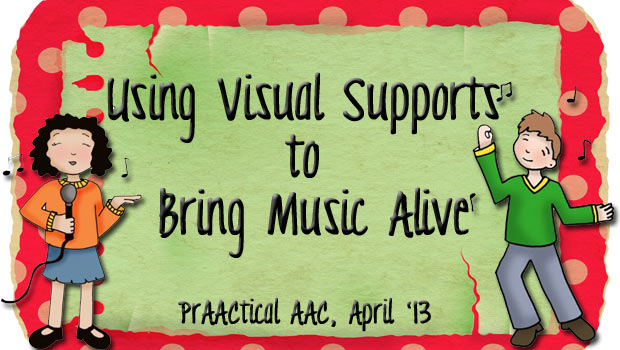
When I first met our guest blogger almost 20 years ago, she was using more visual supports in her music therapy sessions with kids who had ASD than most SLPs were using in their language therapy. Marlene Sotelo has worn many hats in her professional life, but her passion for helping people with ASD communicate more effectively seems to have permeated all of them. In this post, she discusses some of the ways she uses visual supports to help make music therapy effective.
Music is a powerful force that transcends time, cultures, and languages. It can transport you to the past, and bring you hope and excitement for the future. In addition, music can be an effective tool in teaching children with varying abilities. The predictability, rhythmic patterns, and repetitive nature of the structure music lends itself to the development of language, cognitive skills, and motor skills, especially for individuals with disabilities due to its motivating properties. Although I am a trained musician and music therapist, I have seen therapists and teachers use music as an effective and motivating tool with very little training in music. Pre-recorded music can be just as effective as live music in reaching your therapeutic goals if you select the right type of music for the individual you are working with, at the correct level of complexity.
In my work as a music therapist with children with varying developmental disabilities, including Autism Spectrum Disorder, I have found the use of visual supports quite helpful in various ways.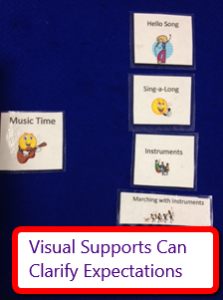
- Visuals can be used during music activities to help clarify expectations, such as a visual schedule of the music activities or songs you will be doing during music time.
- Visuals can be used to allow the child to make choices such as selecting a song to sing or an instrument to play
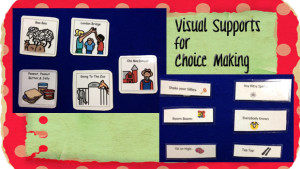
- Visuals can be used to teach and reinforce academic concepts such as the child’s name.
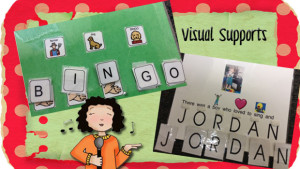
- Visuals can be used to promote active participation even in children that are non-verbal .
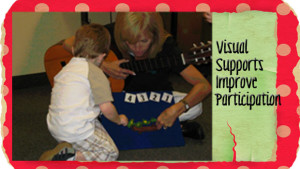
- Incorporating basic AAC devices can also enhance participation in music activities. You can include picture communication symbols and/or a single switch device such as a Big Mac.
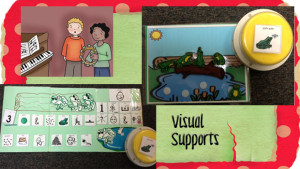
Any song can be adapted using visual supports to promote participation and communication. The key is to select the parts of the song that are repetitive and predictable so that the child is set up for success in their participation. Visuals will help the child know how to participate such as when to clap in the BINGO song, or when to fill in a specific letter.
The most important thing to remember is that music is FUN. So if you are looking for a refreshing way to spice up your teaching or therapy session, let music bring the beat back into your sessions.
—
Marlene Sotelo, Ed.D., BCBA-D, MT-BC, is director of education and training for the Broward County Satellite Office of the UM-NSU Center for Autism and Related Disabilities and an adjunct faculty member at the Center for Psychological Studies and Abraham S. Fischler School of Education. Working in the Broward County School system, she acquired experience as a special education, general education, and inclusion teacher. She has provided therapeutic interventions to children with autism and other developmental disabilities both privately and at the Miami Children’s Hospital Dan Marino Center. She has presented and consulted internationally on effective teaching strategies, curriculum development, program monitoring, and positive behavioral support strategies for children with autism. Marlene is a board certified music therapist, and behavior analyst.
Filed under: PrAACtical Thinking
Tagged With: academics, ASD, choice making, collaboration, Marlene Sotelo, music, music therapy, participation, visual supports
This post was written by Carole Zangari

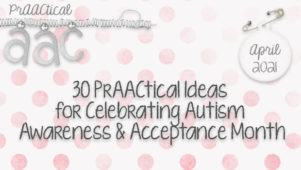
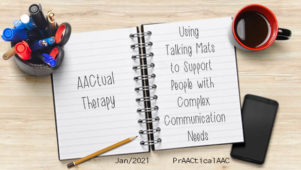
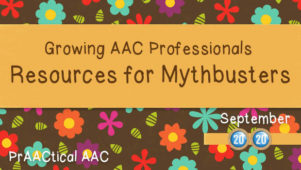
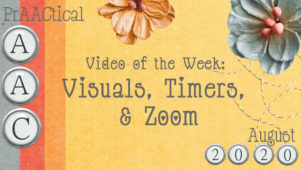
1 Comment
How is it that this site always seems to cover a topic at the exact right moment in our family’s life? My son is non verbal, and IDD. He loves to vocalize when he hears his favorite tunes. However, his sounds do not replicate any part of any song we recognize. I’m still considering ways for him to “sing.”